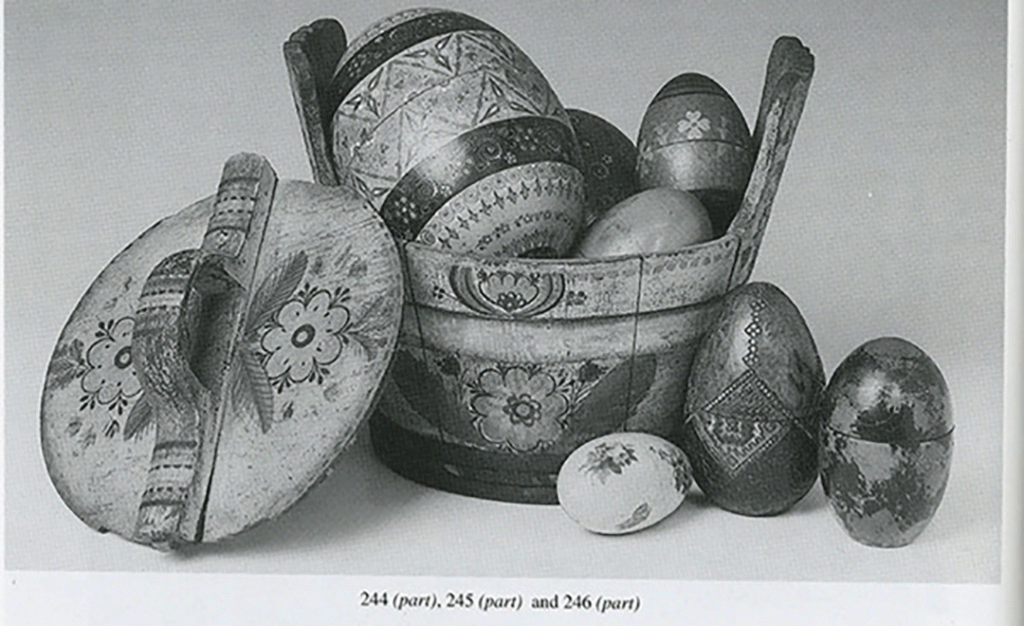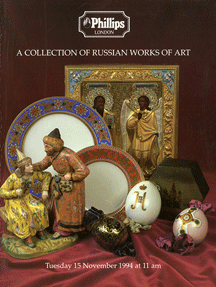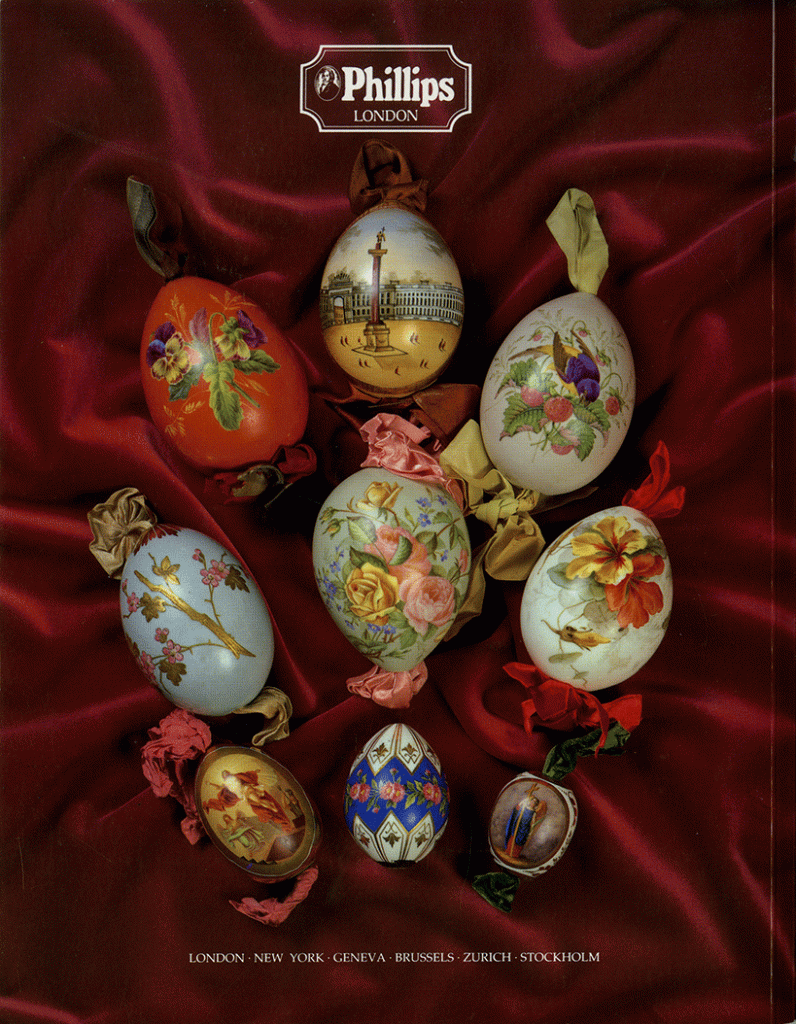Symbolic, Decorative and Accessible: The Enduring Popularity of the Russian Easter Egg as Art Form

Using the collection of eggs owned by Dora Gordine and Richard Hare that were sold at auction in 1994 as a starting point, here volunteer Stella Beaumont explores the rich tradition of the decorated Easter egg in Russia.
Gracing the cover and featuring prominently amongst the lots listed in the auction catalogue of Phillips’ November 1994 sale of Russian art and ceramics from the collection of Dora Gordine and Richard Hare, the couple’s collection of Easter eggs attracted keen bidding interest on the day. Ranging in media, size and value from the group of Russian vernacular wooden eggs shown above, through the lacquered papier-mâché eggs from the Lukutin and Vishnyakov factories, to thirty-eight porcelain eggs (one of which sold for £2000), their success at sale underlined the enduring popularity of this highly collectible genre.
Eggs are of particular importance in Russian culture culture and they feature in various pagan traditions and folk tales. With the rise of Christianity, the giving and receiving of eggs became central to the way in which Russians celebrate Easter. The Easter festival, known in Russia as the ‘feast of feasts’, is considered the most important event in the Russian Orthodox calendar. Eggs are considered to symbolise the death and resurrection of Christ, with the shell representing the sepulchre in which Christ’s body was laid to rest and the yolk the new life emerging from the shell as Christ rose from the dead.[1] The act of giving eggs at Easter has been dated apocryphally to an encounter between Mary Magdalene and the Emperor Tiberius in the early Christian period. Having accepted Mary Magdalene’s gift of an egg, Tiberius denied the resurrection, claiming that it was every bit as impossible as the egg in his hand turning red. At this point, Tiberius’s egg apparently did change to the colour of Christ’s spilt blood and eggs have been painted red ever since.[2]
In the early days of the Russian Orthodox religion, eggs were simply presented, dyed red by boiling with onion skins. According to Ivan Golsky, writing in The Tretyakov Gallery Magazine in 2018, the practice of blessing these simple eggs in church was common in Russia by the 1720s, having been imported from Poland where this practice had begun in 1682.[3] By the 1850s, the basic red egg was being embellished with patterns as egg decoration evolved into a vigorous strand of Russian folk art.
Wooden eggs
The desire to create a more robust and durable version of the hand-painted Easter egg resulted in the production of wooden eggs of the kind featured in the auction catalogue as lots 244 and 245 (shown above). At 19.5 cm and 16.5 cm high respectively, these wooden eggs are larger than their porcelain and papier-mâché counterparts and, whilst not necessarily easy to discern in a black-and-white photograph, the floral and geometric patterns seem more simply inscribed. These particular eggs were neither dated in the catalogue nor attributed to any particular workshop and, in the case of lot 244, there was some uncertainty as to whether all of the eggs were actually Russian. In all likelihood, however, the eggs would have been produced in village workshops by members of the kustari – the class of Russian peasant who lived and worked on the land, supplementing their agricultural wages via crafts such as weaving, spinning and woodturning.
The 1874, the Imperial Russian Geographical Society published a sixteen-volume report on the kustar industries throughout the empire. The report showed that some 7.5 million peasants depended on the production of crafts for survival. Of the five types of peasant crafts identified in the survey – wood, metal, clay, fibres, and skins and furs – woodworking was the most commonly practised and employed the most people. As a material, wood was cheap and widely available and in addition it was considered to be Russia’s ‘material par excellence’.[4]
Although we cannot know for certain when and where Gordine and Hare’s wooden eggs were produced, it is possible they were a product of the so-called Russian Arts and Crafts movement, such as it was, that championed traditional Russian skills and means of production in the face of an increased threat from mechanisation and industrialisation.[5] This revival centred on the Abramstevo estate near Moscow, owned by the rail magnate Savva Mamontov and his wife, which housed a carpentry workshop, set up in 1870, in which young people from rural villages were trained to ‘mend the thread between past and present that modern life seemed to break’.[6] The carpentry workshop turned out works of arts and crafts using the techniques of the kustari with the intention of providing alternative employment to factory working and to bring traditional handmade goods to the eager consumer markets of Moscow and St Petersburg.
Lacquered papier-mâché eggs
Five hand-painted lacquered eggs featured within the lots of Russian lacquered boxes sold at the November 1994 auction. Such lacquered boxes were popular from the start of the eighteenth century when they were in demand throughout Europe as receptacles for tobacco (snuff-boxes). Their production centred on two factories: Korobov, founded in 1793 in the village of Danilkovo and later renamed Luktutin in 1824, and Vishnyakov, founded in the early nineteenth century. Demand for snuff-boxes had dropped by the 1860s, and the factories began focusing on producing other lacquered items, including Easter eggs. Two of the eggs sold at auction were attributed to the celebrated Lukutin factory and one to the Vishnyakov factory. In 1904, the Lukutin factory closed and some of the artists relocated to Vishnyakov, which carried on operating until the 1917 Revolution, whilst other artists worked from home. From 1910 until 1916, the Lukutin artists established a cooperative craft society, called an artel, at the village of Fedoskino, a larger, neighbouring village to Danilkovo. They later recommenced their work in the 1930s. Other villages, such as Palekh, Mstera and Kholuy, which were important centres for icon painting prior to the Revolution, began to focus on producing papier-mâché lacquered items after 1917.
Production of lacquered papier-mâché began with the pressing and forming of cardboard sheets which were then boiled in linseed oil and then baked in an oven. Thereafter the material could be worked like wood and artists could begin fine painting on the blank surfaces. Although Lukutin was focused primarily on producing goods for the upper classes and Vishnyakov looked more to the general population, a fierce rivalry had grown up between the two factories following Lutukin’s takeover of the Korobov factory. Competition spurred innovation and the range of items produced was extended to include brooches, tea caddies, spectacle cases, the aforementioned Easter eggs, and other items.
The eggs sold in the auction of Gordine and Hare’s collection were base painted in the traditional Easter red colour and combined religious and secular scenes in separate halves of the same egg – perhaps acknowledging their Russian customers’ dual loyalties to Church and state. Production of these lacquered items was at its height in the mid-1800s and carried on until Lukutin’s closure in 1904.[7]
Porcelain eggs

Porcelain eggs constituted the majority of eggs in Gordine and Hare’s collection, with thirty-eight individual eggs listed in the November 1994 auction catalogue.

Three of the porcelain eggs were highlighted on the auction catalogue cover. To the front centre of the cover sits a richly decorated egg with a deep blue-black background with gilded bands and panels that sold for £1100; to the bottom right is a lilac egg with a gilded cross described as painted in the ‘Old Russia’ style that sold for £480; and in the centre is a white porcelain egg bearing the cypher of Nicholas II that sold for £2000. Whilst in every case the price achieved far exceeded the estimate, the particularly high price associated with the white porcelain egg may be due to its provenance: author and academic Venetia Newall references the royal family’s giving of white porcelain eggs like this one to favoured courtiers.[8]
Porcelain eggs had been produced at the Imperial Porcelain Factory in St Petersburg from the time of its establishment in 1744. Founded by Empress Elizabeth and originally called the Neva Porcelain Manufactory, it became the Imperial Porcelain Factory in 1765. The chemist Dmitry Vinogradov, who developed the formula for Russian porcelain, wrote in his journal from 1749: ‘Today we turned and moulded the [Easter] eggs’.[9]
In his book The Art and Artists of Russia (1965), Richard Hare is slightly dismissive of Vinogradov who was apparently given to bouts of drunkenness and whose production was limited in volume if high in quality, suggesting that it was only later, under the personal direction of Catherine the Great (1762–1796), that the factory came into its own.[10] Porcelain goods, including Easter eggs, were produced as presents for both visiting statesmen, favoured courtiers and members of the imperial family. It was, however, under Nicholas I (1796–1855) that the giving of eggs became an established practice to mark birthdays, anniversaries and other important dates including, of course, Easter. Production was scaled to meet demand and, in an article on Easter eggs, Newall quotes a traveller to pre-revolutionary Russia who noted that ‘scarcely any material is to be named that is not made into Easter eggs. At the Imperial glass cutting manufactory we saw two halls filled with workmen employed on nothing else, but on cutting flowers and figures on eggs of crystal glass.’[11]

These eggs were larger and more intricately decorated than those that had come before them and introduced a wider range of subject matter with images of saints, landscapes and the reproduction of scenes from celebrated paintings, some of which are now located in the State Hermitage Museum, proving particularly popular. In his article on Easter eggs from the Imperial Porcelain Factory, Golsky notes that the works of the Italian baroque artist Guido Reni were much replicated.[12] Although most of the eggs from Gordine and Hare’s collection were decorated largely with generic floral designs or showed scenes from the Bible, one of the eggs featured the view from the Admiralty building in St Petersburg as shown on the back cover of the catalogue.
Summary
Prior to researching this history of Gordine and Hare’s collection of eggs sold at auction, I had only one point of reference for Russian eggs and that was the famous and highly prized Easter eggs produced by the house of Fabergé. It has become clear to me, however, that whilst the fifty intricate, be-jewelled and ingeniously designed Fabergé Easter eggs, produced between 1885 and 1916 as gifts for the Russian royal family, have dominated the popular narrative, these simply sit at the luxurious apogee of a creative tradition dating back many centuries and embraced by all classes of Russian society. The simpler woodturned, lacquered and porcelain eggs owned by Gordine and Hare have just as important a part to play in portraying Russian enthusiasm for the Easter festival and for the eggs produced to celebrate it.
I was also curious to find out what happened to Easter egg production after the 1917 Revolution and was interested to learn that the focus of production at the Imperial Porcelain Factory, renamed the State Porcelain Factory, became porcelain plates bearing revolutionary slogans rather than porcelain eggs for favoured courtiers. Many of the imperial treasures, including the Romanov Fabergé collection, largely liberated by Lenin in 1917, were sold off by Stalin to foreign collectors to raise capital under the ‘Treasures into Tractors’ initiative.[13] In 2004, however, nine Fabergé eggs owned by the American Forbes family were sold in a private sale to a prominent Russian industrialist and are now housed in the Fabergé museum in St Petersburg – emblematic of changing attitudes towards Russia’s imperial treasures on the part of the state.[14]
Lastly, I was keen to explore whether Easter itself remained a focal point for Russians. For some seventy years after the revolution, Russia had pursued a pro-atheism and anti-religion strategy with the Russian Orthodox Church suppressed, many churches closed, church-goers barred from membership of The Communist Party and the celebration of Easter discouraged.[15] With Gorbachev’s election came a change in attitude towards religion with a New York Times report noting that in 1988, for the first time in memory, Soviet television broadcast several minutes of the Orthodox Easter ceremony.[16] In April 2020, the Kremlin Press Service reported President Vladimir Putin as saying, ‘The great holiday of Easter fills people’s hearts with joy and hope, with faith in the all-conquering power of life, in the triumph of goodness, love and justice. These enduring ideals and values hold our people together and help us withstand difficult trials’.[17]
In this context, the grassroots practice of boiling, dying, painting, gifting and rolling eggs at Easter looks set to thrive, whilst inspired curation of the kind recently undertaken by the Walters Art Museum, Baltimore – pairing Fabergé eggs with an exhibition of large-scale digital prints by the contemporary artist Jonathan Monaghan – creates the opportunity for new audiences to view these traditional masterpieces in a new light.[18]
Stella Beaumont
Published as part of the project The Squatter Years: Recovering Dorich House Museum’s Recent Past, funded by the National Lottery Heritage Fund, January 2021.
[1] Vera Ivanova, ‘The Russian Tradition of Easter Eggs’, Russia-IC, 24 April 2019, http://russia-ic.com/culture_art/traditions/5339/#.X9IPIS2cZQI.
[2] ‘Mary Magdalene’, Orthodox Wiki, https://orthodoxwiki.org/Mary_Magdalene.
[3] Ivan Golsky, ‘Easter Eggs from the Imperial Porcelain Factory’, The Tretyakov Gallery Magazine, 59.2 (2018), https://www.tretyakovgallerymagazine.com/articles/2-2018-59/easter-eggs-imperial-porcelain-factory.
[4] Wendy Salmond, ‘The Abramtsevo Workshops’, in Arts and Crafts in Late Imperial Russia: Reviving the Kustar Art Industries, 1870–1917 (Cambridge: Cambridge University Press, 1996), pp.15–45, https://digitalcommons.chapman.edu/cgi/viewcontent.cgi?article=1002&context=art_books.
[5] Rosalind Blakesley, ‘Artisans and Aristocrats: The Russian Equation’, in The Arts and Crafts Movement (London: Phaidon, 2006), pp.159–74.
[6] Wendy Salmond, ‘The Russian Avant-Garde of the 1890s: The Abramtsevo Circle’, The Journal of the Walters Art Museum, 60/61 (2002/2003), 7–13, http://www.jstor.org/stable/20168612.
[7] ‘Fedoskino Lacquer Boxes’, The Russian American Company, https://www.russianamericancompany.com/fedoskino-lacquer-boxes/ and ‘Lukutin & Vishyakov’, The Russian American Company, https://www.russianamericancompany.com/lukutin-vishnyakov/.
[8] Venetia Newall, ‘Easter Eggs’, The Journal of American Folklore, 80.315 (1967), 3–32, https://doi.org/10.2307/538415.
[9] Golsky, ‘Easter Eggs from the Imperial Porcelain Factory’, https://www.tretyakovgallerymagazine.com/articles/2-2018-59/easter-eggs-imperial-porcelain-factory.
[10] Richard Hare, ‘Porcelain of the Russian Empire’, in The Arts and Artists of Russia (London: Methuen, 1965), p.141.
[11] Newall, ‘Easter Eggs’, https://doi.org/10.2307/538415.
[12] Golsky, ‘Easter Eggs from the Imperial Porcelain Factory’, https://www.tretyakovgallerymagazine.com/articles/2-2018-59/easter-eggs-imperial-porcelain-factory.
[13] Sean McMeekin, ‘Treasures into Tractors: The Selling of Russia’s Cultural Heritage, 1918–1938’, Soviet and Post Soviet Review, 37.2 (November 2010), 195–97, https://www.researchgate.net/publication/270721470_Treasures_into_Tractors_The_Selling_of_Russia%27s_Cultural_Heritage_1918-1938.
[14] ‘Fabergé Museum in Saint Petersburg’, Wikipedia, https://en.wikipedia.org/wiki/Fabergé_Museum_in_Saint_Petersburg.
[15] ‘Revelations from the Russian Archives: Anti-Religious Campaigns’, Library of Congress, 31 August 2016, https://www.loc.gov/exhibits/archives/anti.html.
[16] Bill Keller, ‘On the Russian Easter, Believers See Greater Soviet Tolerance’, The New York Times, 11 April 1988, https://www.nytimes.com/1988/04/11/world/on-the-russian-easter-believers-see-greater-soviet-tolerance.html.
[17] ‘Putin Congratulates Orthodox Christians and all Russian Citizens who Celebrate Easter’, Russian News Agency, 18 April 2020, https://tass.com/russia/1146763.
[18] ‘Contemporary Art Paired with Faberge Eggs at the Walters Art Museum’, Art Daily, 1 January 2018, https://artdaily.cc/news/101436/Contemporary-art-paired-with-Faberge-Eggs-at-the-Walters-Art-Museum#.X_YAey2cZQI.

